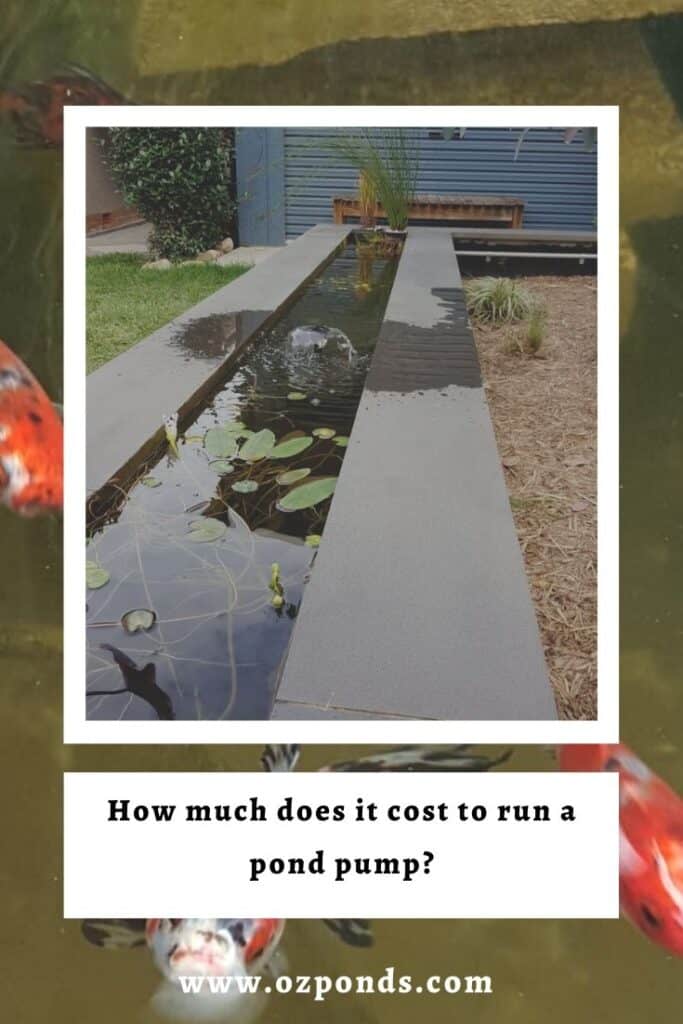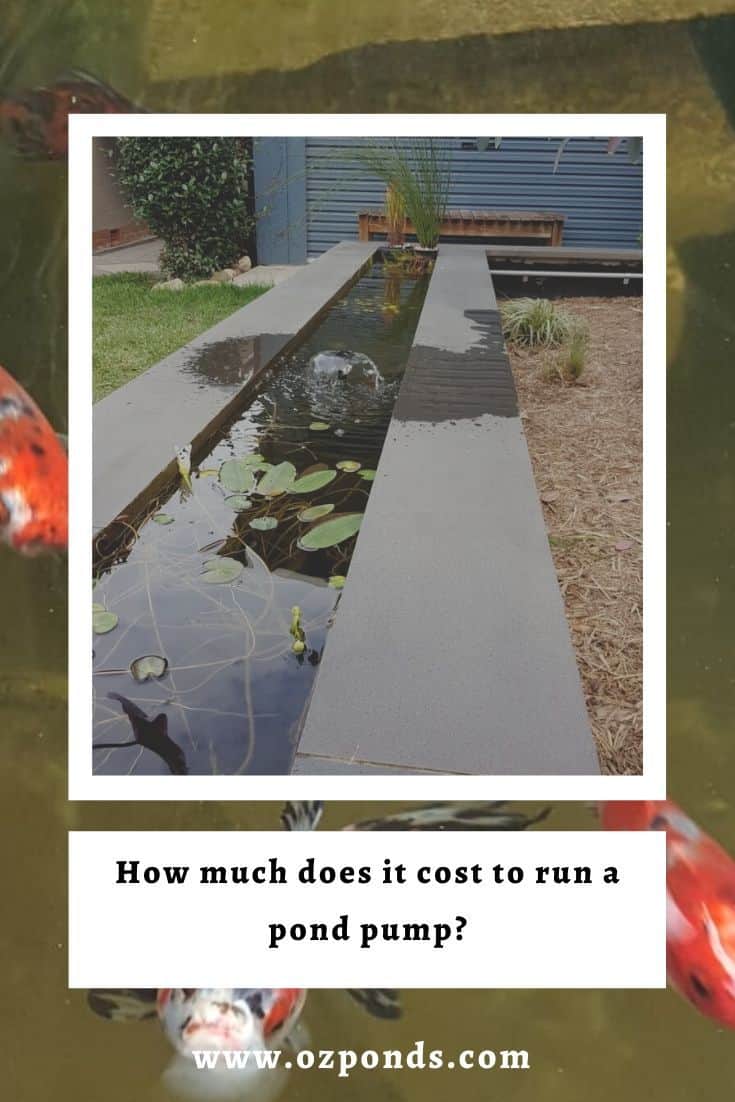Quite often people are worried about how much it will cost to run a pond pump. Sometimes that will make them put it on a timer or not use one all together.
I believe that your pond pump should run 24/7. Pond pumps are always making improvements in energy efficiency. Keeping an eye on what’s available can save you dollars.
To calculate how much a pump costs to run its as simple as calculating; (cost of electricity per kilowatt) X (the amount of kilowatts the pump uses).
To collect this information all you need is a power bill and the specs of your particular pond pump.
The table below can give you a quick reference at how much it will cost you to run a pond pump.
The top row is the amount that you pay for electricity. The left column is the wattage of the pond pump.
| 10cents per kWh | 15cents per kWh | 20cents per kWh | 25cents per kWh | 30cents per kWh | 35cents per kWh | |
| 5 watt pump | $0.012 per day or $4.38 per year | $0.018 per day or $6.57 per year | $0.024 per day or $8.76 per year | $0.03 per day or $10.95 per year | $0.036 per day or $13.14 per year | $0.042 per day or $15.33 per year |
| 10 watt pump | $0.024 per day or $8.76 per year | $0.036 per day or $13.14 per year | $0.048 per day or $17.52 per year | $0.06 per day or $21.90 per year | $0.072 per day or $26.28 per year | $0.084 per day or $30.66 per year |
| 20 watt pump | $0.048 per day or $17.52 per year | $0.072 per day or $26.28 per year | $0.096 per day or $35.04 per year | $0.12 per day or $43.80 per year | $0.144 per day or $52.56 per year | $0.168 per day or $61.32 per year |
| 50 watt pump | $0.12 per day or $43.80 per year | $0.18 per day or $65.70 per year | $0.24 per day or $87.60 per year | $0.30 per day or $109.50 per year | $0.36 per day or $131.40 per year | $0.42 per day or $153.30 per year |
| 100 watt pump | $0.24 per day or $87.60 per year | $0.36 per day or $131.40 per year | $0.48 per day or $175.20 per year | $0.60 per day or $219.00 per year | $0.72 per day or $262.80 per year | $0.84 per day or $306.60 per year |
| 150 watt pump | $0.36 per day or $131.40 per year | $0.54 per day or $197.10 per year | $0.72 per day or $262.80 per year | $0.90 per day or $328.50 per year | $1.08 per day or $394.20 per year | $1.26 per day or $459.90 per year |
| 200 watt pump | $0.48 per day or $175.20 per year | $0.72 per day or $262.80 per year | $0.96 per day or $350.40 per year | $1.20 per day or $438.00 per year | $1.44 per day or $525.60 per year | $1.68 per day or $613.20 per year |
Some examples of doing the calculations
For example the cost of my electricity is 26 cents per kilowatt. This is 26 cents for every 1000 watts of power.
I have a pump on my front pond that draws 45 watts per hour. So the calculation goes.
0.045 (watts converted to kilowatts, simply divide the watts by 1000) X 0.26 cents (Cost of electricity per kilowatt)= 0.0117 Cents per hour.
So per day thats. 0.0117cents X 24hrs = 0.2808 Cents per day!
Over a year the pump costs me- 0.2808 cents X 365 = $102.49. So there you have it my 45 watt an hour pump will cost me approximately $102.49 to run each year. Running 24/7
I have 2 pumps on my small aquaponic systems drawing 20 watts per hour. Here’s how the calculations go.
0.02 (watts converted to kilowatts) X 0.26 cents (My cost of electricity per kilowatt) = 0.0052 cents per hour.
0.0052 X 24hrs = 0.1248 cents per day!
Over the course of a year each pump will cost me- $45.56.
A large pond using 180 watts per hour will cost this much. At my current cost of electricity.
0.180 (watts converted to kilowatts) X 0.26 cents (My electricity cost per kilowatt) = 0.0468 cents per hour.
0.0468 cents X 24 = $1.1232 per day!
$1.1232 X 365 = $409.97 per year.
Reduce the cost
The easiest way to reduce the cost of your pond pump is to check how many litres it is pumping and how many watts it consumes.
It’s amazing how different the watts being consumed can be for the same amount of water circulation.
For example my front pond consumes 45 watts per hour and pumps 2500 litres per hour. While my large aquaponic system pond pump also consumes 45 watts per hour, yet it has an output of 4600 litres an hour.
That’s almost double the water circulation for the same energy cost!
It pays to do the research early. Usually the more efficient the model the more the upfront cost, although not always.
Another good tip is to use this website (for those in Victoria) to see if you can find a cheaper energy provider.
I’m always shocked when I hear how much some people are paying for power, simply because they can’t be bothered switching!! That website is free all you need is a recent bill and it will do the calculations for you.
While we are talking about energy providers those with peak and off peak might serve you best.
Like a lot of Australians we have solar power. This allows the house to run off the solar energy (pond pumps included) during the daylight (majority peak time) hours. Then during the nighttime (majority off peak) we use energy from the grid.
The off peak rate is currently 10.5 cents per kilowatt for us this significantly reduces the cost per day/year for the examples I gave earlier in the article.
Lastly to help reduce the cost of running your pond pump. Carry out regular maintenance! I aim to check my pumps once a month (although I must admit I can be a bit slack).
Ensuring there are no blockages and obstructions around the pump cage and any filtration sponges will help the pump run at maximum efficiency.
Low volt vs 240 volt
When shopping for a pond pump you may notice that there are low volt pumps (12-24 volts) and normal 240 volt pumps.
240 volt pumps will generally consume less power. However you need to have a 240volt power point near your pond. Is your pond is outside and away from the house this can be a significant expense because an electrician is required to put in an outdoor power point.
A low volt pond pump requires a transformer. The transformer changes the bolts from 240v into low volt 12-24v. The transformer uses some extra watts to perform this function. And that’s why a low volt pump will use more power.
Low volt pumps however do have an advantage in that they are safe to extend yourself. Without the need of an electrician you can extend a 12volt pump up to 30 metres and a 24volt pump up to 70 metres.
Some people market low volt as a safer option around water. All my pumps are low volt but this is more because I was able to get them where I wanted them without needing to pay for outdoor electricity.
Subscribe
If you haven’t already be sure to subscribe to our mailing list. We receive special offers and discounts from suppliers that we are more than happy to share with our readers.


